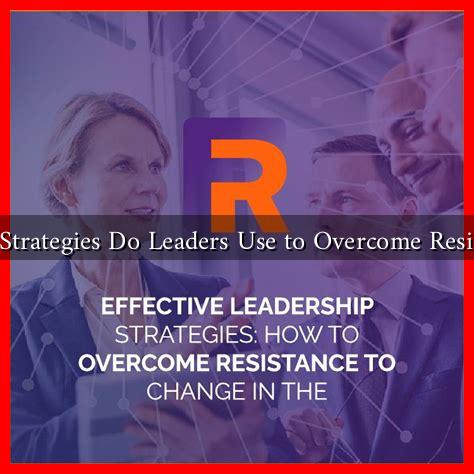-
Table of Contents
What Strategies Do Leaders Use to Overcome Resistance
Resistance to change is a common phenomenon in organizations, often stemming from fear, uncertainty, or a lack of understanding. Effective leaders must employ various strategies to navigate this resistance and foster a culture of adaptability. This article explores the key strategies leaders use to overcome resistance, supported by examples and case studies.
Understanding Resistance to Change
Before delving into strategies, it is essential to understand the nature of resistance. Resistance can manifest in several ways, including:
- Active opposition, such as protests or vocal dissent.
- Passive resistance, including apathy or lack of engagement.
- Subtle sabotage, where individuals undermine initiatives without overtly opposing them.
Recognizing these forms of resistance is crucial for leaders aiming to implement change effectively.
Key Strategies for Overcoming Resistance
1. Effective Communication
One of the most powerful tools leaders have is communication. Clear, transparent communication helps to alleviate fears and clarify the reasons behind changes. Leaders should:
- Articulate the vision and benefits of the change.
- Encourage open dialogue, allowing team members to voice concerns.
- Utilize multiple channels (meetings, emails, newsletters) to reach all stakeholders.
For instance, when Microsoft transitioned to a cloud-first strategy, CEO Satya Nadella emphasized the importance of communication. He held town hall meetings to explain the vision and address employee concerns, which helped mitigate resistance.
2. Involvement and Participation
Involving employees in the change process can significantly reduce resistance. When individuals feel they have a stake in the outcome, they are more likely to support the initiative. Leaders can:
- Form focus groups to gather input on proposed changes.
- Encourage team members to contribute ideas and solutions.
- Assign roles in the change implementation process.
A notable example is the case of General Electric (GE) under former CEO Jack Welch. Welch implemented a “work-out” process where employees at all levels could contribute to decision-making, leading to greater buy-in and reduced resistance.
3. Training and Support
Providing adequate training and support is essential for easing the transition. Employees may resist change due to a lack of skills or confidence in their ability to adapt. Leaders should:
- Offer training programs tailored to new processes or technologies.
- Provide ongoing support through mentorship or coaching.
- Establish feedback mechanisms to address concerns during the transition.
For example, when IBM shifted its focus to cloud computing, it invested heavily in training its workforce. This commitment not only reduced resistance but also empowered employees to embrace new technologies confidently.
4. Building Trust and Relationships
Trust is a critical component in overcoming resistance. Leaders who build strong relationships with their teams can foster a more supportive environment. Strategies include:
- Being transparent about challenges and setbacks.
- Recognizing and rewarding contributions to the change process.
- Demonstrating empathy and understanding towards employee concerns.
Research from the Harvard Business Review indicates that organizations with high trust levels experience less resistance to change. Leaders like Indra Nooyi, former CEO of PepsiCo, exemplified this by prioritizing employee well-being and fostering a culture of trust.
Case Studies and Statistics
According to a study by McKinsey, 70% of change initiatives fail, often due to employee resistance. However, organizations that implement effective strategies can see significant improvements. For instance, a case study on Procter & Gamble revealed that their structured approach to change management, which included communication and employee involvement, led to a 30% increase in project success rates.
Conclusion
Overcoming resistance to change is a multifaceted challenge that requires strategic leadership. By employing effective communication, involving employees, providing training, and building trust, leaders can create an environment conducive to change. As organizations continue to evolve, the ability to manage resistance will remain a critical skill for leaders. Embracing these strategies not only facilitates smoother transitions but also fosters a culture of resilience and adaptability.
For further reading on change management strategies, consider exploring resources from the McKinsey Organization Blog.


